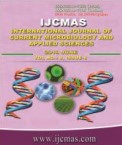


 National Academy of Agricultural Sciences (NAAS)
National Academy of Agricultural Sciences (NAAS)

|
PRINT ISSN : 2319-7692
Online ISSN : 2319-7706 Issues : 12 per year Publisher : Excellent Publishers Email : editorijcmas@gmail.com / submit@ijcmas.com Editor-in-chief: Dr.M.Prakash Index Copernicus ICV 2018: 95.39 NAAS RATING 2020: 5.38 |
The rapid emergence of multiresistant microbial pathogens is a serious threat to human health. Extended spectrum beta lactamase (ESBL)-producing Escherichia coli is a superbug causing worldwide outbreaks, CTX-M has become the most commonly detected ESBL genotype; these enzymes have become predominant worldwide, the most common type of CTX-M reported in various geographic regions is CTX-M15. A total of 80 Escherichia coli (E. coli) isolates were recovered from different clinical samples of intensive care units (ICUs) patients. These isolates were identified by Matrix-assisted laser desorption ionization–time of flight mass spectrometry (MALDI-TOF MS), in vitro antimicrobial susceptibility was investigated by VITEK 2 instrument, ESBL production was assessed phenotypically and ESBL genes (TEM, SHV and CTX-M15) confirmed genotypically by PCR and further confirmation for CTX-M15 by DNA sequencing. More than 50% of ESBL E. coli isolates were multidrug resistant; while carbapenams remains the most active compound among the studied isolates. Among ESBL E. coli, CTX-M-15 was 90% which was confirmed by sequencing. To our knowledge, this is the first report to study CTX-M-15 in E. coli isolates in Sharkia governorate. This study showed a high rate of ESBL E. coli with the widespread dissemination of CTX-M-15 which emphasize the need for employing an excellent management program in antibiotic therapy.
 |
 |
 |
 |
 |